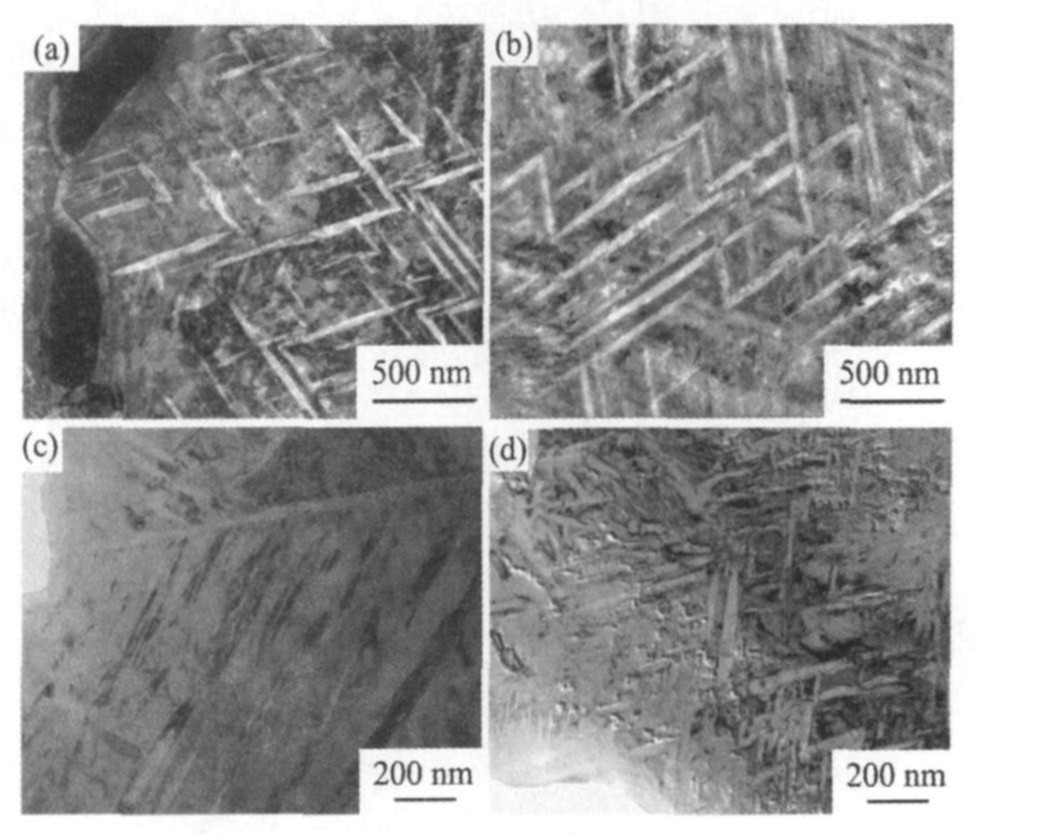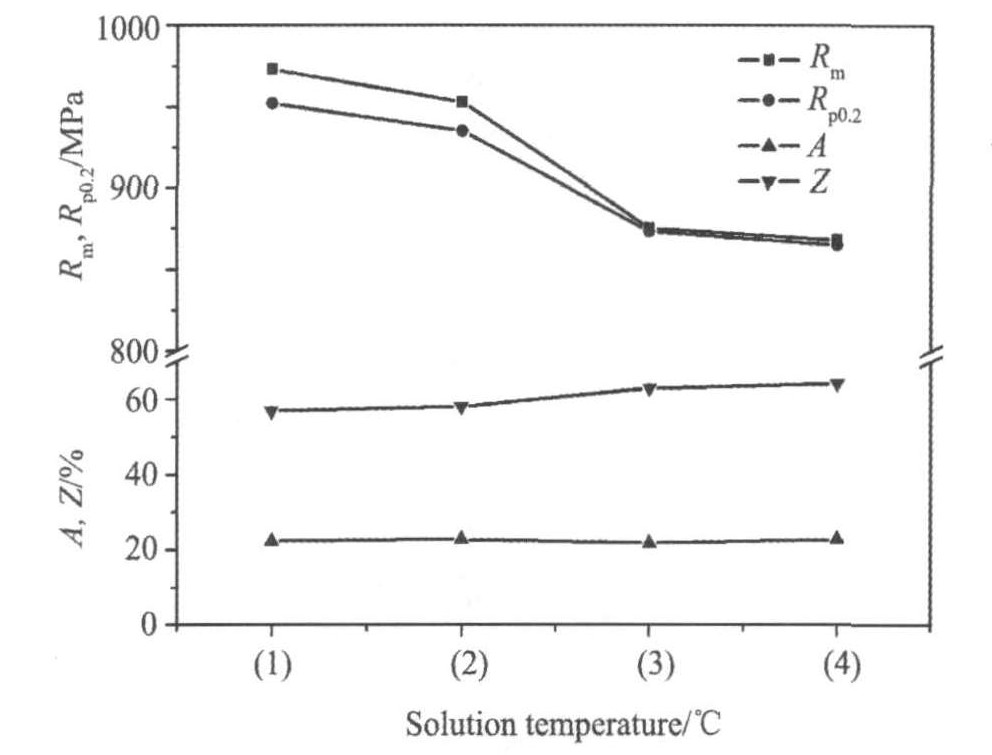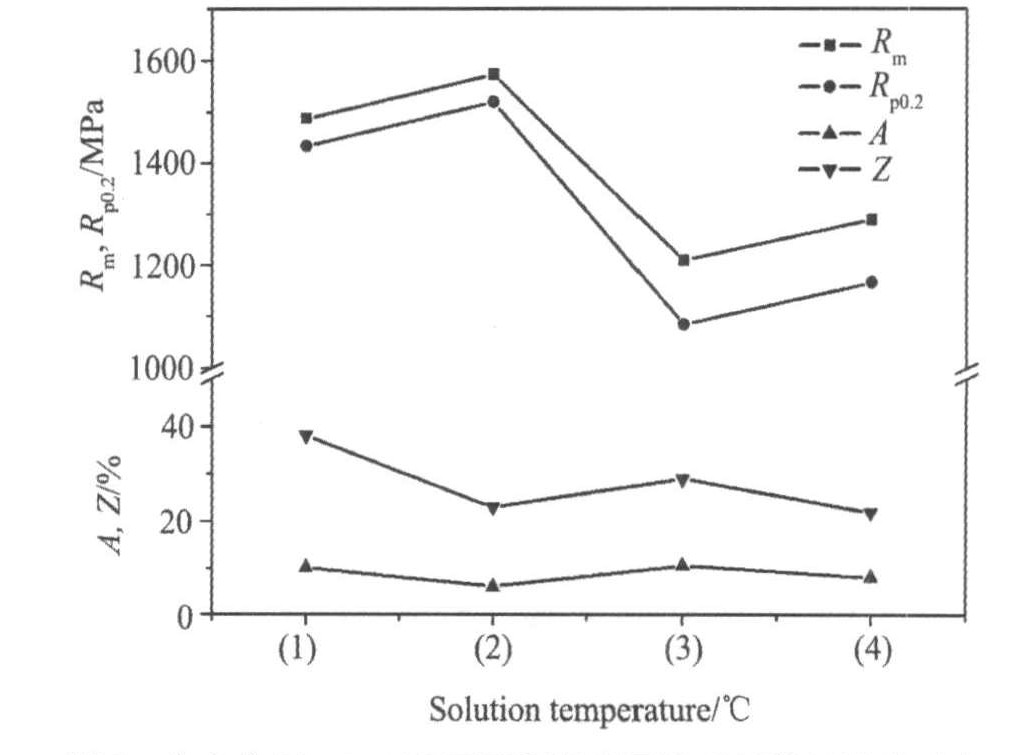固溶处理对Ti-6Cr-5Mo-5V-4Al合金组织与性能的影响
宝钛集团有限公司
北京有色金属研究总院有色金属材料制备加工国家重点实验室
摘 要:
研究了固溶处理对一种新型Ti-6Cr-5Mo-5V-4A l合金组织与室温拉伸性能的影响。研究发现:Ti-6Cr-5Mo-5V-4A l合金在α/β固溶处理后的典型组织为:变形拉长的β晶粒,晶粒破碎,原始β晶界处有项链状初生α相析出,经时效后,晶内则析出纵横交错的细小次生α相。β固溶处理后的典型组织为:等轴β晶粒,经时效后晶界处沿着一定取向析出次生α相薄片层,晶内弥散分布着平行交错的细小次生α相。随着固溶温度的升高,β晶粒尺寸逐渐增大,初生α相的含量逐渐减少,相转变温度以上固溶处理后初生α相完全消失。α/β固溶+时效后显微组织中次生α相尺寸较小,大小均匀,长度在500 nm左右;而β固溶+时效后显微组织中次生α相尺寸较大,且大小不均,长度在2001500 nm左右。该合金经固溶处理后具有中等强度水平和良好的塑性,且在实验温度范围内,固溶温度越高,合金强度越低,塑性越好;经时效后,α/β固溶处理的时效强化效应明显强于β固溶处理后,强度差值达360 MPa,主要是因为α/β固溶处理后初生α相的析出,导致残余β相更加稳定,时效时次生α相的驱动力小,以及残余大量的位错等缺陷为α相提供了较多的形核位置,因此次生α相尺寸细小且分布均匀弥散。
关键词:
中图分类号: TG156.94
作者简介:张平辉(1970-),男,陕西人,硕士,高级工程师;研究方向:钛合金(E-mail:zhangph902@163.com);
收稿日期:2010-12-10
基金:国家科技支撑计划(2008BAE62B03)资助项目;
Effect of Solution Treatment on Microstructure and Tensile Properties of Ti-6Cr-5Mo-5V-4Al Alloy
Abstract:
Effect of solution treatment on microstructures and tensile properties of a new type Ti-6Cr-5Mo-5V-4Al alloy was studied.The experimental results showed that,the microstructure feature of Ti-6Cr-5Mo-5V-4Al solution treated in α/β region was that elongated and broken β grains due to deformation,accompanied with a necklace-shaped primary α phase at the prior β grain boundary,and consequently after aging,showing a fine,intragranular secondary α phase with acicular shape.But the microstructure feature of the alloy solution treated in β region was that coarsen equiaxial β grains due to recrystallization,subsequently aging showed a secondary α platelets along the preferred orientation at prior β grain boundary,and also intragranular secondary α phase with acicular shape but much thicker.With the solution temperature increased,β grain increased and volume fraction of primary α phase decreased and vanished finally when treatment at β phase region.Secondary α phase was quite fine and uniform with approximately 500 nm in length due to treated in α/β region plus aging,on the contrary,it was a little coarser and nonuniform with 2001500 nm in length due to treatment at β region plus aging.The treated alloy solution presented a moderate strength levels with a preferable ductility.With increasing the solution temperature,tensile strength decreased and ductility was optimized.And owing to subsequently aging treatment,aging hardening response of the alloy solution treated in α/β region was more preferable than treated in β region with a different of 300 MPa in strength,which mainly because secondary α phase was more finer and uniform when treated in α/β region plus aging,in this case,the remained β phase was more stable due to the precipitation of primary α phase.
Keyword:
metastable β titanium alloy;solution treatment;microstructure;tensile properties;
Received: 2010-12-10
钛是20世纪50年代兴起的一种重要结构金属, 同其他结构金属相比, 钛及钛合金比强度、 比刚度高, 抗腐蚀性能、 高低温性能、 抗疲劳和抗裂纹扩展性能优良, 具有优良的综合力学性能, 是一种很有发展潜力和应用前景的结构材料
Ti-6Cr-5Mo-5V-4Al合金是中国宝钛集团最新研发的一种新型亚稳定β钛合金, 该合金的设计按照多元强化及铝当量与钼当量匹配的原则。 本文以此为研究对象研究了Ti-6Cr-5Mo-5V-4Al合金Ф12 mm~Ф16 mm轧制棒材在不同固溶条件下的显微组织特点、 室温拉伸性能及二者之间的关系。
1 实 验
1.1材料
实验材料为真空自耗电弧二次熔炼的Ti-6Cr-5Mo-5V-4Al合金铸锭, 经开坯、 锻造、 轧制得到Ф12~Ф16 mm棒材。 用淬火金相法测得该合金的β相转变温度为780~790 ℃。 根据文献
1.2方法
从轧制棒材上切取拉伸、 金相试样, 并分别在α/β区(730 ℃/30 min/AC和760 ℃/30 min/AC)和β区(800 ℃/30 min/AC和830 ℃/30 min/AC)进行不同温度的固溶处理后, 进行时效处理(460 ℃/6 h/AC)。 然后分别对固溶态和固溶+时效态的试样进行显微组织分析及室温拉伸性能检测。 拉伸试样采用Ф5 mm的标准拉伸试样,每组试样采用3根平行试样求取平均值。 拉伸性能测试按照GB/T228-2002金属室温拉伸试验方法进行。 金相腐蚀剂采用: HF:HNO3∶H2O=1∶3∶7配比溶液。 SEM分析在FEI QUANTA 400仪器上进行。 透射样品经机械减薄至40 μm后进行电解双喷。 电解双喷采用MTP-1A型磁力驱动双喷电解减薄仪, 6%高氯酸+34%正丁醇+60%甲醇混合液作为电解液, 电解液温度在-45 ℃左右, 电流为20 mA左右。 在JEM-2100透射电子显微镜上进行观察分析。
表1Ti-6Cr-5Mo-5V-4Al合金化学成分(%, 质量分数)
Table 1Chemical composition of the alloy(%, mass fraction)
| Ti | Cr | Mo | V | Al | Fe | Si | C |
| Bal. | 5.700 | 4.700 | 4.810 | 3.930 | 0.080 | 0.028 | 0.025 |
2 结果与讨论
研究了Ti-6Cr-5Mo-5V-4Al钛合金固溶态以及固溶+时效态的显微组织与室温拉伸性能之间的关系。
2.1固溶处理后的显微组织
固溶处理可以有效减小或消除合金热加工过程中由于变形不均匀、 冷却速度不同等造成的组织不均匀性。 β钛合金在β相转变温度以上进行固溶处理后会生成粗大的β晶粒, 在稍低于β相转变温度下固溶处理会析出初生α相, 而初生α相对合金的性能影响很大
图1为Ti-6Cr-5Mo-5V-4Al钛合金经不同温度固溶处理后的显微组织。 从中可看出, α/β固溶处理后显微组织具有明显的轧制加工组织, 主要是变形拉长的β晶粒和初生α相(图1(a), (b))。 初生α相呈现非常细小的粒状, 在光学显微镜下难以进行辨别, 在扫描电镜照片中可以清晰看出(图2(a), (b)所示), 初生α相主要在原始的β晶界处析出, 尺寸在0.5~2 μm左右, 而且, 随着固溶温度升高, 初生α相的含量明显减少, 当固溶温度升高至相转变温度以上时(800和830 ℃), 由于发生再结晶, 初生α相完全消失, 生成完整的晶界平直的等轴β相。 随着固溶温度升高, β晶粒的尺寸也在逐渐增大。 800 ℃固溶后晶粒尺寸在 40 μm左右, 830 ℃固溶后晶粒尺寸, 在50~100 μm之间(图1(c), (d))。
2.2固溶+时效处理后的显微组织
图2是Ti-6Cr-5Mo-5V-4Al钛合金在不同温度固溶经460 ℃/6 h/AC时效后的显微组织。 从中可见, α/β固溶+时效处理后的显微组织中, 除了具有固溶处理后的组织特征外, 还有时效过程析出的次生α相, 此时的次生α相, 尺寸非常细小, 在SEM照片中无法辨认, 而在TEM照片中可以清晰的看出(图3(a), (b)所示), 时效析出的次生α相细小且分布弥散, 长度在500 nm左右。 β固溶+时效处理后, 原始的β晶界处沿着一定取向析出针状次生α相, 尺寸较大, 长度在1 μm左右; 而晶内析出的次生α相弥散分布, 但尺寸大小较不均匀, 长度在200~2000 nm之间(图2(c), (d)和图3 (c), (d)), 夹角成60°左右。 4种不同的固溶温度下, 均有弥散析出的针状次生α相, 这些平行的片层结构间, 又有许多短的针状次生α相形成, 两种形态的次生α相由于尺寸和取向不同, 相互交错, 这些在晶内和晶界处析出纵横交错的次生α相, 能有效阻止位错运动, 具有很高的强化效应, 使合金强度处于较高水平
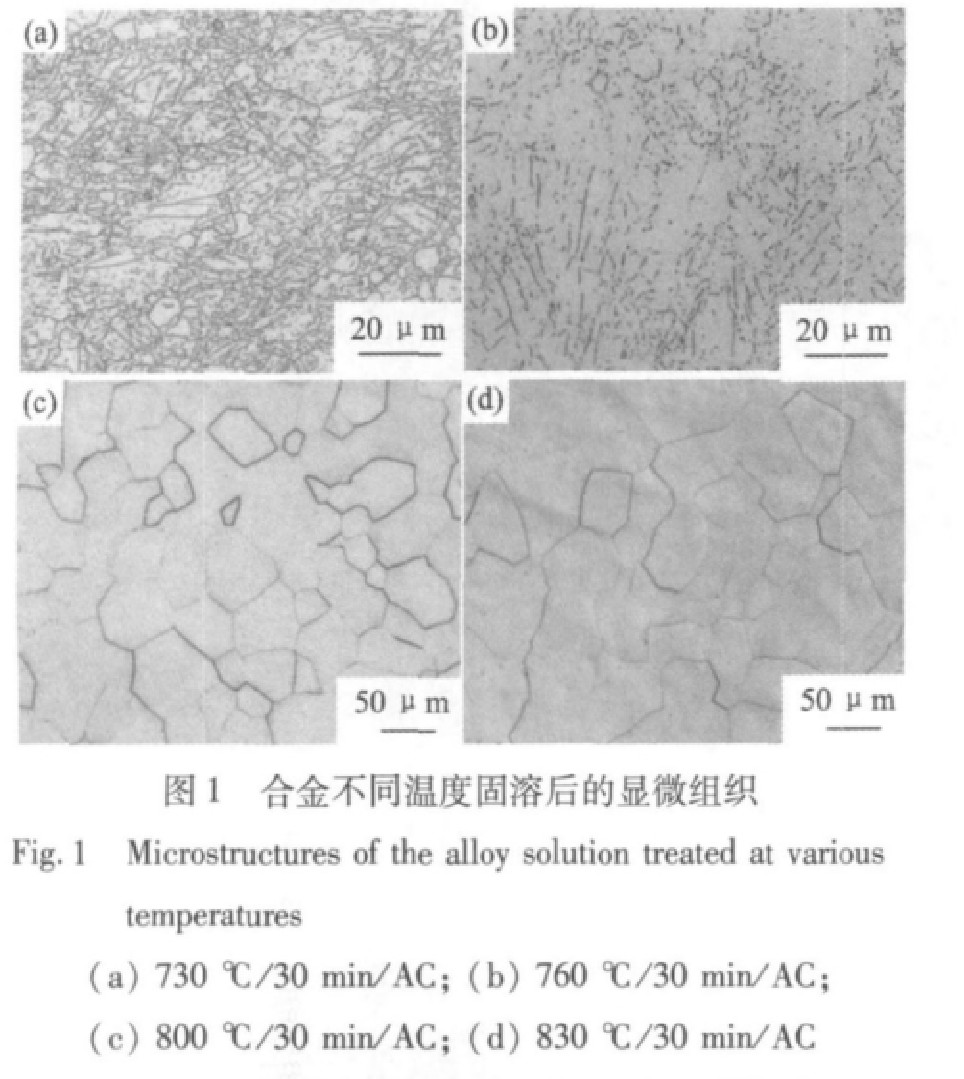
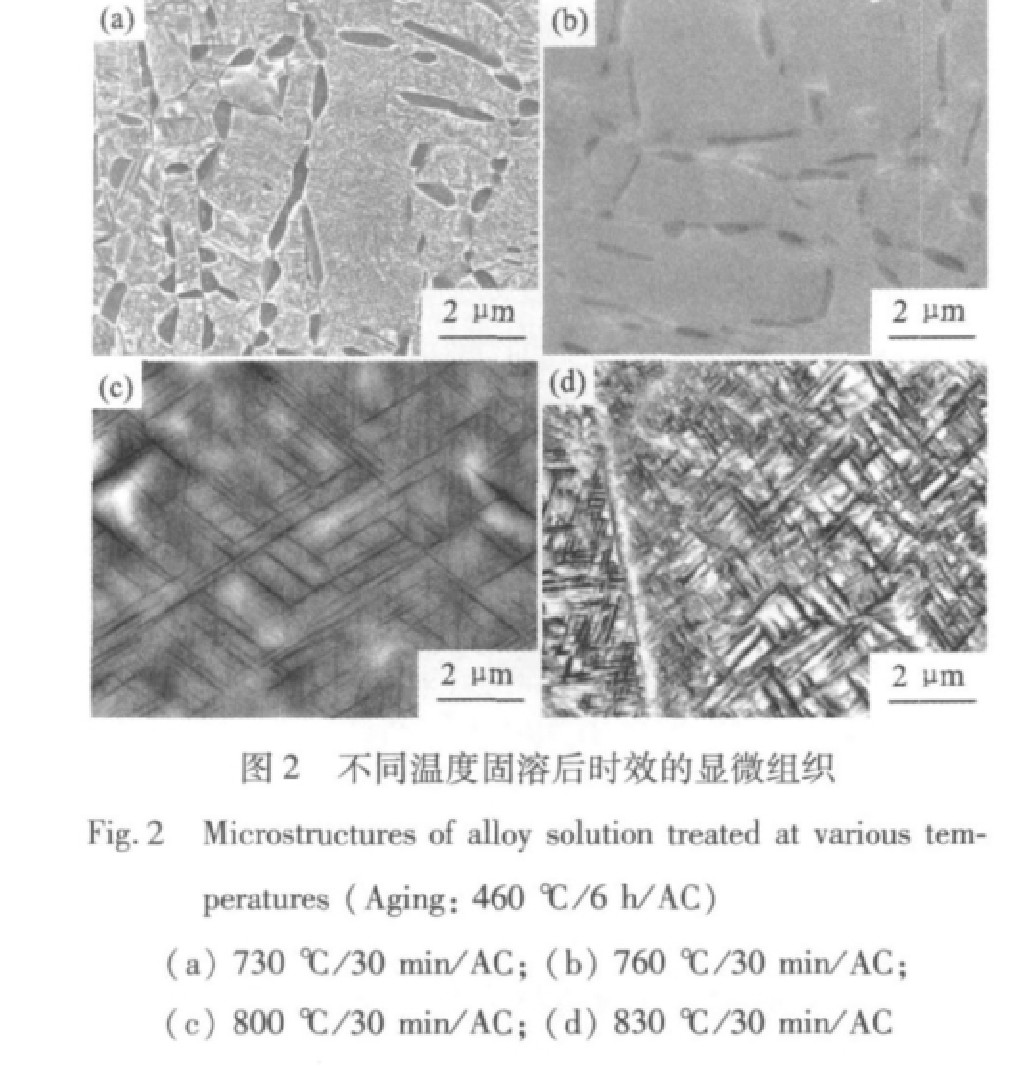
2.3固溶温度对合金性能的影响
β钛合金的固溶处理温度一般选择在相变转变温度附近, 加热温度, 保温时间与冷却方式是固溶处理的控制条件, 其中固溶温度最为重要。 固溶温度对合金的相组成、 分布、 尺寸以及后续的时效响应影响很大。 尽管提高加热温度会使合金元素溶解更充分, 合金元素的分布也更均匀, 但温度过高会导致晶粒剧烈长大, 使合金塑性降低
图3 不同温度固溶后时效的TEM照片
Fig.3 TEM micrographs of the alloy solution treated at various temperatures (Aging: 460 ℃/6 h/AC) (a), (b) 760 ℃/30 min/AC; (c), (d)800 ℃/30 min/AC
Ti-6Cr-5Mo-5V-4Al钛合金不同温度固溶处理后的室温拉伸性能见图4。 从中可看出, 合金固溶处理后具有中等水平强度和良好的塑性, 且在实验温度范围内, 固溶温度越高, 合金强度越低, 塑性越好。 这是因为, hcp 结构的初生α相具有一定的强化作用, 随着固溶温度升高, 组织中的初生α相含量逐渐减少, 最终为单一的β相(图1所示), 而具有bcc结构的β相则具有良好的塑形
图5是Ti-6Cr-5Mo-5V-4Al钛合金在不同温度固溶经460 ℃/6 h/AC时效后的室温拉伸性能对比。 从中可以看出, 460 ℃/6 h/AC时效后, α/β固溶处理的时效强化效应明显强于β固溶处理后, 差值达360 MPa。 此性能差异如此之大, 是由它们的显微组织差别所决定的。 而β钛合金的强度和塑性很大程度上由时效过程析出的次生α相的形貌、 尺寸和分布特征所决定。 如前所述, α/β固溶+时效处理时, 次生α相细小且分布弥散,长度在500 nm左右; 而β固溶+时效处理后, β晶界处析出的次生α相, 尺寸较大, 长度在1 μm左右; 而晶内析出的次生α相弥散分布, 但尺寸大小较不均匀, 长度在200~2000 nm之间。 总体上来说, α/β固溶+时效处理后次生α相尺寸更细小, 分布更均匀。 原因有两方面, 其一, α/β固溶处理后, 由于初生α相的析出, 残余的β相所含的β稳定化元素含量增多, 因此β相的稳定性提高, 在时效过程中, α相析出的相变驱动力较小, 因此次生α相的尺寸较小
图4 合金不同温度固溶后的性能对比
Fig.4 Comparison of properties of alloy after solution treated at various temperatures and 30 min/AC
(1) 730 ℃/30 min/AC; (2) 760 ℃/30 min/AC;(3) 800 ℃/30 min/AC; (4) 830 ℃/30 min/AC
图5 合金在30 min/AC下不同温度固溶后时效的性能对比
Fig.5 Comparisons of properties of the alloy after solution treated at various temperatures (Aging: 460 ℃/6 h/AC) and 30 min/AC
(a) 730 ℃/30 min/AC; (b) 760 ℃/30 min/AC;(c) 800 ℃/30 min/AC; (d) 830 ℃/30 min/AC
3 结 论
1. Ti-6Cr-5Mo-5V-4Al合金在α/β固溶处理后的典型组织为: 变形拉长的β晶粒, 晶粒破碎, 经时效后原始β晶界处有项链状初生α相析出, 晶内则析出纵横交错的细小次生α相。 β固溶处理后的典型组织为: 等轴β晶粒, 经时效后晶界处沿着一定取向析出次生α相薄片层, 晶内弥散分布着平行交错的细小次生α相。
2. Ti-6Cr-5Mo-5V-4Al合金经固溶处理后具有中等水平强度和良好的塑性, 且在实验温度范围内, 固溶温度越高, 合金强度越低, 塑性越好。
3. Ti-6Cr-5Mo-5V-4Al合金经固溶+时效处理后强度可达1200~1500 MPa等级, 同时保持优良的塑性(延伸率6%~10.5%), 但α/β固溶处理后的时效强化效应明显强于β固溶处理, 差值达360 MPa。 主要是因为α/β固溶+时效处理后的次生α相尺寸细小且分布均匀弥散。
参考文献
[4] Leyens C,Peters M.Titanium and Titanium Alloys[M].Bei-jing:Chemical Industry Press,2005.
[11] Gerd Lutjering,James C.Williams Titanium[M].Germany:Spinger,2003.
[12] Froes F,Bomberger HB.The beta titaniumalloys[J].Journalof Metals,1985,(7):28.
[15] Donachie M J.Titanium:A Technical Guide[R].ASMInt,2000.
[4] Leyens C,Peters M.Titanium and Titanium Alloys[M].Bei-jing:Chemical Industry Press,2005.
[11] Gerd Lutjering,James C.Williams Titanium[M].Germany:Spinger,2003.
[12] Froes F,Bomberger HB.The beta titaniumalloys[J].Journalof Metals,1985,(7):28.
[15] Donachie M J.Titanium:A Technical Guide[R].ASMInt,2000.


